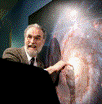Department of Physics and Astronomy: Publications and Other Research

C. Martin Gaskell Publications
Document Type
Article
Date of this Version
1-2008
Abstract
We discuss the use of Sloan Digital Sky Survey (SDSS) ugriz point-spread function (PSF) photometry for setting the zero points of UBVRI CCD images. From a comparison with the Landolt (1992, AJ, 104, 340) standards and our own photometry we find that there is a fairly abrupt change in B, V, R, and I zero points around g, r, i ∼ 14.5, and in the U zero point at u ∼ 16. These changes correspond to where there is significant interpolation due to saturation in the SDSS PSF fluxes. There also seems to be another, much smaller systematic effect for stars with g, r > 19.5. The latter effect is consistent with a small Malmquist bias. Because of the difficulties with PSF fluxes of brighter stars, we recommend that comparisons of ugriz and UBVRI photometry should only be made for unsaturated stars with g, r, and i in the range 14.5–19.5, and u in the range 16–19.5. We give a prescription for setting the UBVRI zero points for CCD images, and general equations for transforming from ugriz to UBVRI.


Comments
Published in The Astronomical Journal, 135:264–267, 2008 January doi:10.1088/0004-6256/135/1/264 Copyright 2008. The American Astronomical Society. Used by permission.